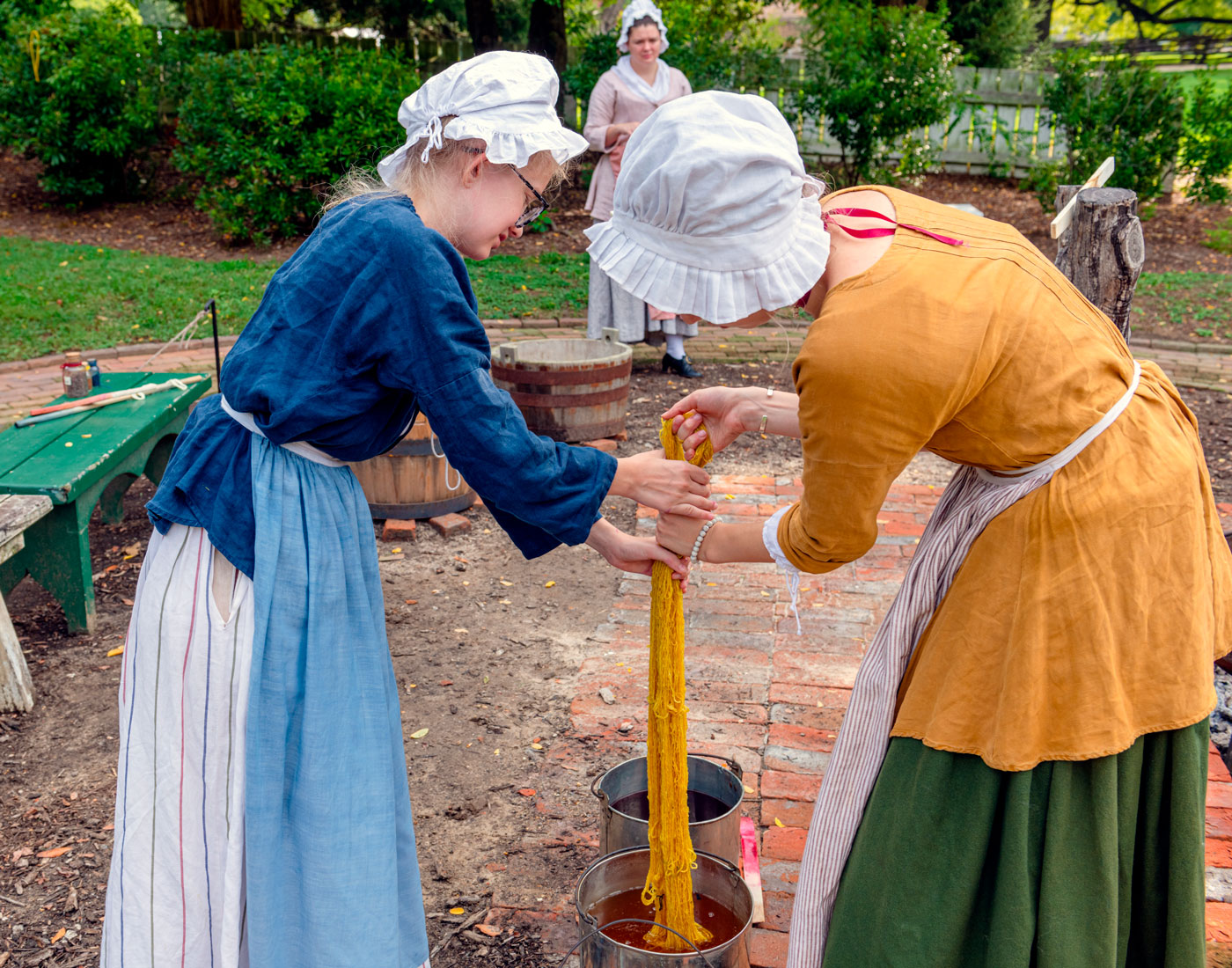Preparing for Dye Days
Every month we, the Weavers, head out to our dye yard to experiment with various dye recipes, where we invite guests to see this process in action. But before you join us, here’s a little background on all of the work that goes into these monthly “Dye Days.”
Our shop master, Karen Clancy, likes to compare Dye Day to Thanksgiving Dinner; hours or even days of preparation for just a few hours of enjoyment. We research, spin, ply, scour, mordant, cook, and strain before we are able to dye. Here, we’d like to dive into just two of these many steps for a little background.
Scouring
We must scour our wool yarn in order to achieve great dyeing results. This process rids the fiber of microscopic waxes, oils, and debris which could prevent the dye from sticking permanently. We like to describe it as a “deep clean.”

The process of scouring has been described in various 18th-century receipt books with the most common ingredient used being fermented urine. The function of such is detailed in Claude Louis Berthollet’s 1792 publication Elements of the Art of Dying. Knowing what we know today, we typically opt for Jim Liles’ scouring recipe found in his book The Art of Craft of Natural Dyeing. It is important to note that scouring protein fibers (i.e. wool and silk) is very different from scouring cellulose fibers (i.e. linen and cotton).
Here is our most used wool scouring recipe taken from “The Art and Craft of Natural Dyeing” by Jim Liles:
- “Use 4 to 6 gallons of hot (120º to 140º F) water per pound of wool. Any nonreactive vessel is suitable.
- Optional: add 1 tablespoon of Calgon water softener, particularly if the water is hard.
- Add 1 to 2 level tablespoons Ivory Liquid, Tide, or similar detergent. [We use Dawn dish soap]
- Place the yarn, fleece, or piece goods in the solution. If yarn or fleece, do not agitate. Agitation causes felting. The materials should remain in the solution for at least 2 hours - overnight is excellent. Turn the materials occasionally. If the yarn or fleece is especially dirty or oily, the materials may be removed, gently drained, and placed in a new identically prepared solution.
- Finally, rinse gently with water of approximately the same temperature was the scouring water at the time of removal.”

Mordanting
After our fiber is well-scoured we will often apply a mordant. Mordant comes from the Latin word mordere which means to bite. It is commonly a water-based solution containing a metallic salt that attaches to the fiber, allowing the dye to stick more permanently. This step is done to ensure colorfastness. Some natural dyes do not require a mordant (black walnut hulls and indigo are two examples), but most natural dyes do require a mordant. Just like the recipe for scouring is different for protein and cellulose fibers, the same is true for mordanting. To make things even more complex, you can achieve very different colors from one dye bath using different mordants (i.e. iron mordant vs. alum mordant). We tend to use an alum mordant to achieve the truest color of the dye on wool, as was common practice in the 18th century.

Here is our most used wool mordant taken from Max Hamrick’s “Organic Fiber Dyeing: The Colonial Williamsburg Method”.
- Soak the to-be-dyed yarn in clean water for at least 72 hours. This will thoroughly wet all the molecules of the yarn and make it receptive to the dyeing.
- Add 3 to 4 gallons of water to a large pot.
- Add 6 ounces of alum to the water and stir thoroughly. (we often add 1 ounce of cream of tartar to even out the mordant)
- Place the yarn into the mixture and slowly bring to a gentle boil for 1 hour.
- The yarn should stay in the mordant water until it is ready to be placed into the dye bath.

Join Us
You can see that there is a lot of time and work that goes into just two steps of preparation for our Dye Days! Because we are only able to demonstrate dyeing once a month we would like to provide all the upcoming Dye Day dates, so that we can share the beauty and intriguing discoveries of our monthly experiments. Use your admission ticket to join us behind the Weaving shop. We hope to see you there!
Check the weaver shop page for upcoming dye days.

Love fiber arts and want to immerse yourself in these skills? Join us for our one-hour drop spindle class for beginners or our two-hour weaving workshop for all levels.
By Karen, Annie, Aubrey, Ellie, and Joe
The Weavers of the Colonial Williamsburg Foundation
